The Cambridge History of China. Vol. 13: Republican China 1912-1949, Part 2
Подождите немного. Документ загружается.

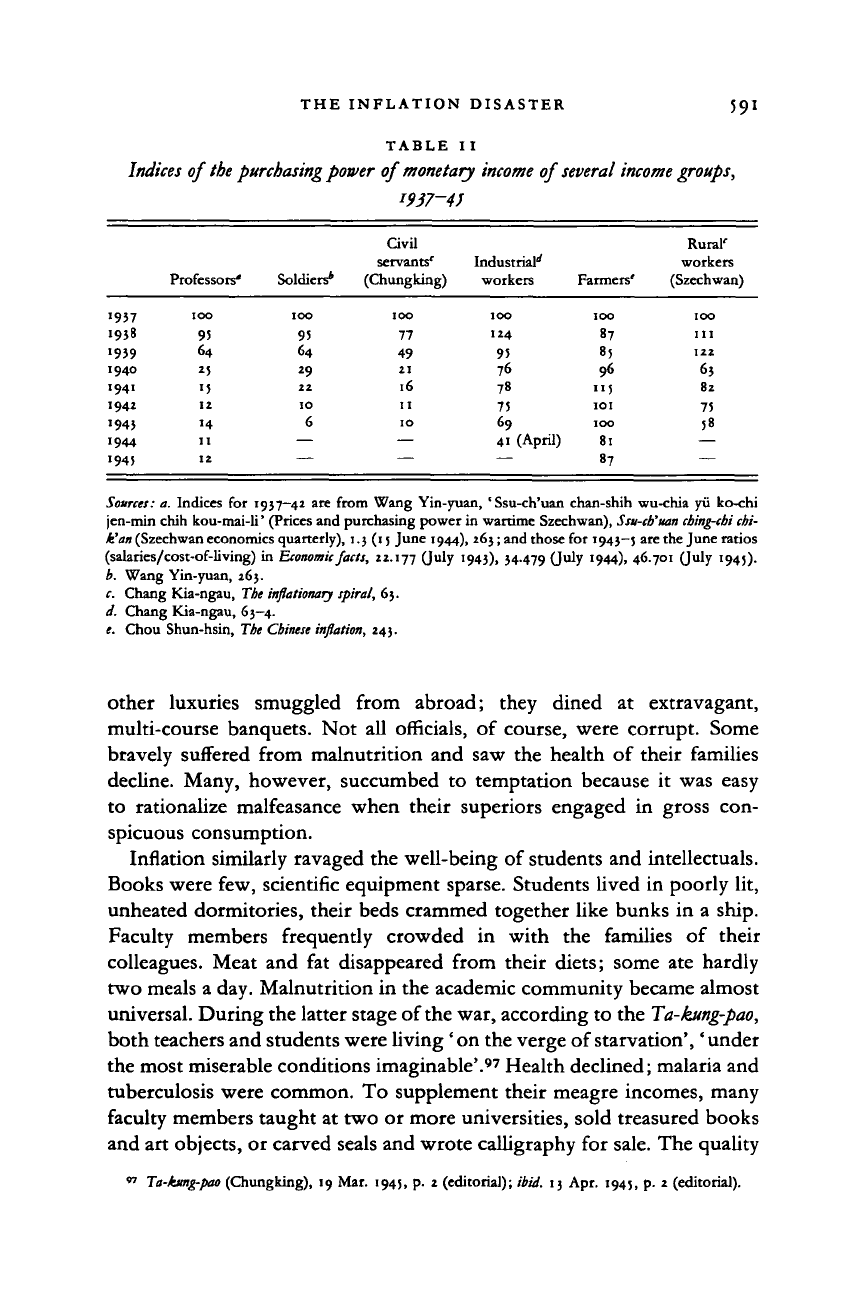
THE INFLATION DISASTER 591
TABLE II
Indices
of
the purchasing power
of
monetary income
of
several income groups,
I937-4J
1957
1938
1939
1940
1941
1942
1943
1944
1945
Professors*
100
9!
64
25
15
12
'4
11
12
Soldiers*
100
95
64
2
9
22
10
6
—
Civil
servants'
(Chungking)
100
77
49
21
16
11
10
—
Industrial''
workers
100
124
95
76
78
75
69
41 (April)
~~
Farmers'
100
87
85
96
115
101
100
81
87
Rural'
workers
(Szechwan)
100
in
122
63
82
75
58
—
Sources:
a. Indices
for
1957-42 are from Wang Yin-yuan, 'Ssu-ch'uan chan-shih wu-chia yvi ko-chi
jen-min chih kou-mai-li' (Prices and purchasing power in wartime Szechwan),
Ssu-cb'uan cbing-chi
chi-
li
an
(Szechwan economics quarterly), 1.3 (15 June 1944),
263;
and those for
1943—5
are the June ratios
(salaries/cost-of-living) in Economic facts, 22.177 (July 1943), 34-479 (J^y '944)> 46701 (July 194;).
b. Wang Yin-yuan, 263.
c. Chang Kia-ngau, The
inflationary
spiral,
63.
d. Chang Kia-ngau, 63—4.
e. Chou Shun-hsin, The
Chinese
inflation,
243.
other luxuries smuggled from abroad; they dined
at
extravagant,
multi-course banquets. Not
all
officials,
of
course, were corrupt. Some
bravely suffered from malnutrition and saw the health
of
their families
decline. Many, however, succumbed
to
temptation because
it
was easy
to rationalize malfeasance when their superiors engaged
in
gross con-
spicuous consumption.
Inflation similarly ravaged the well-being of students and intellectuals.
Books were few, scientific equipment sparse. Students lived in poorly lit,
unheated dormitories, their beds crammed together like bunks in
a
ship.
Faculty members frequently crowded
in
with
the
families
of
their
colleagues. Meat and
fat
disappeared from their diets; some ate hardly
two meals a day. Malnutrition in the academic community became almost
universal. During the latter stage of the war, according to the
Ta-kung-pao,
both teachers and students were living 'on the verge of starvation', 'under
the most miserable conditions imaginable'.
97
Health declined; malaria and
tuberculosis were common. To supplement their meagre incomes, many
faculty members taught at two or more universities, sold treasured books
and art objects, or carved seals and wrote calligraphy for sale. The quality
97
Ta-hmg-pao
(Chungking), 19 Mar. 1945, p. 2 (editorial);
ibid.
13 Apr. 1945, p. 2 (editorial).
Cambridge Histories Online © Cambridge University Press, 2008
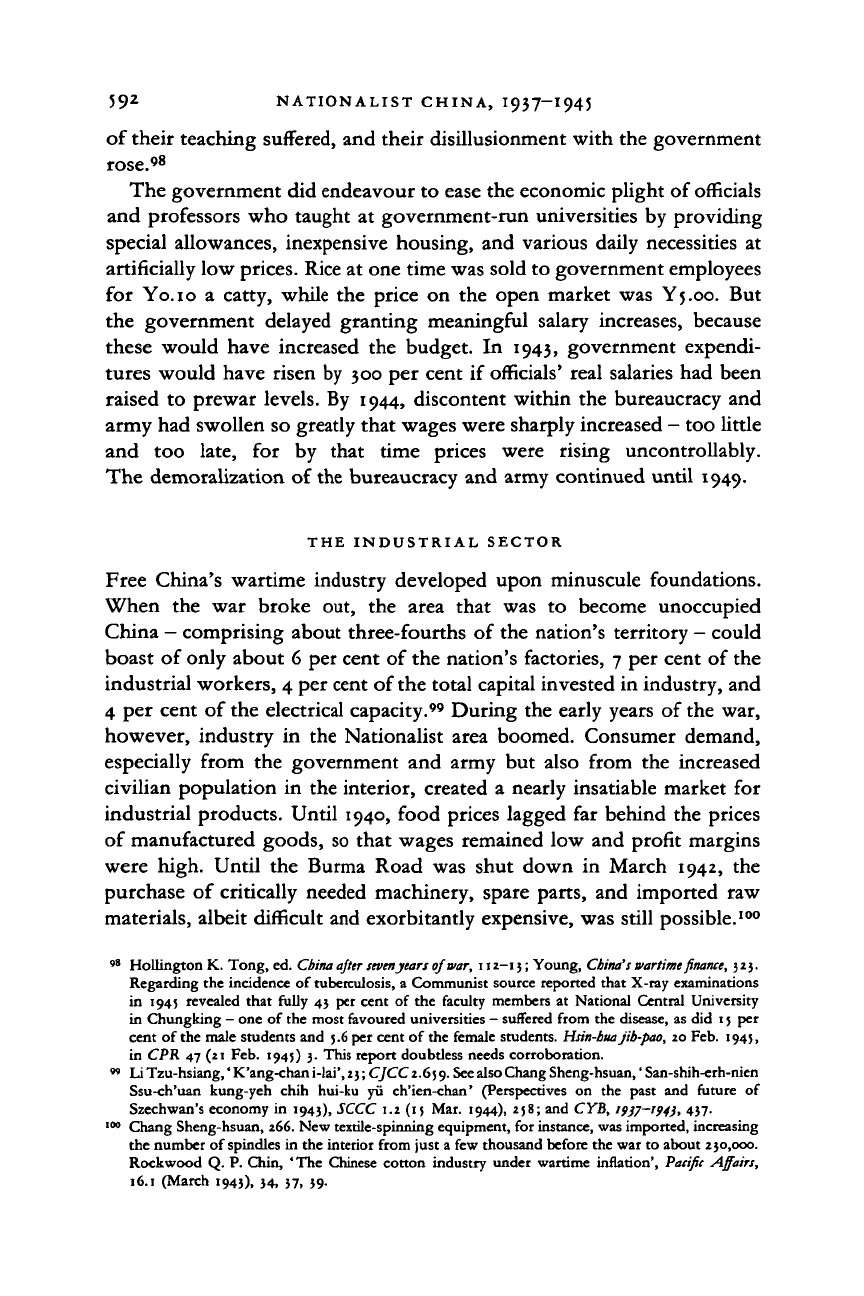
59
2
NATIONALIST CHINA, I937-I945
of their teaching suffered, and their disillusionment with the government
rose.
98
The government did endeavour to ease the economic plight of officials
and professors who taught
at
government-run universities by providing
special allowances, inexpensive housing, and various daily necessities
at
artificially low prices. Rice at one time was sold to government employees
for Yo.io
a
catty, while the price
on
the open market was Y5.00. But
the government delayed granting meaningful salary increases, because
these would have increased the budget.
In
1943, government expendi-
tures would have risen by 300 per cent
if
officials' real salaries had been
raised
to
prewar levels. By 1944, discontent within the bureaucracy and
army had swollen so greatly that wages were sharply increased
-
too little
and
too
late,
for by
that time prices were rising uncontrollably.
The demoralization of the bureaucracy and army continued until 1949.
THE INDUSTRIAL SECTOR
Free China's wartime industry developed upon minuscule foundations.
When
the war
broke out,
the
area that was
to
become unoccupied
China
-
comprising about three-fourths
of
the nation's territory
-
could
boast of only about 6 per cent of the nation's factories, 7 per cent of the
industrial workers, 4 per cent of the total capital invested in industry, and
4 per cent of the electrical capacity." During the early years of the war,
however, industry
in
the Nationalist area boomed. Consumer demand,
especially from the government and army but also from the increased
civilian population
in
the interior, created
a
nearly insatiable market for
industrial products. Until 1940, food prices lagged far behind the prices
of manufactured goods, so that wages remained low and profit margins
were high. Until the Burma Road was shut down
in
March 1942,
the
purchase
of
critically needed machinery, spare parts, and imported raw
materials, albeit difficult and exorbitantly expensive, was still possible.
100
" Hollington
K.
Tong.ed. China after sevenjears ojwar, 112—13; Young, China's wartime finance,
323.
Regarding the incidence
of
tuberculosis,
a
Communist source reported that X-ray examinations
in 1945 revealed that fully
43
per cent
of
the faculty members
at
National Central University
in Chungking
-
one
of
the most favoured universities
-
suffered from the disease, as did
15 per
cent
of
the male students and 5.6 per cent
of
the female students. Hsin-bua jib-poo, 20 Feb. 194;,
in
CPR
47 (21 Feb. 1945)
3.
This report doubtless needs corroboration.
M
Li Tzu-hsiang,' K'ang-chan i-lai',
23;
CJCC 2.659. See also Chang Sheng-hsuan,' San-shih-erh-nien
Ssu-ch'uan kung-yeh chih hui-ku
yii
ch'ien-chan' (Perspectives
on the
past
and
future
of
Szechwan's economy
in
1943), SCCC 1.2 (15 Mar. 1944), 258; and
CYB,
1937—1943,
437.
100
Chang Sheng-hsuan, 266. New textile-spinning equipment, for instance, was imported, increasing
the number
of
spindles in the interior from just a few thousand before the war to about 230,000.
Rockwood Q.
P.
Chin, 'The Chinese cotton industry under wartime inflation', Pacific Affairs,
16.1 (March 1943), 34, 37,
39.
Cambridge Histories Online © Cambridge University Press, 2008
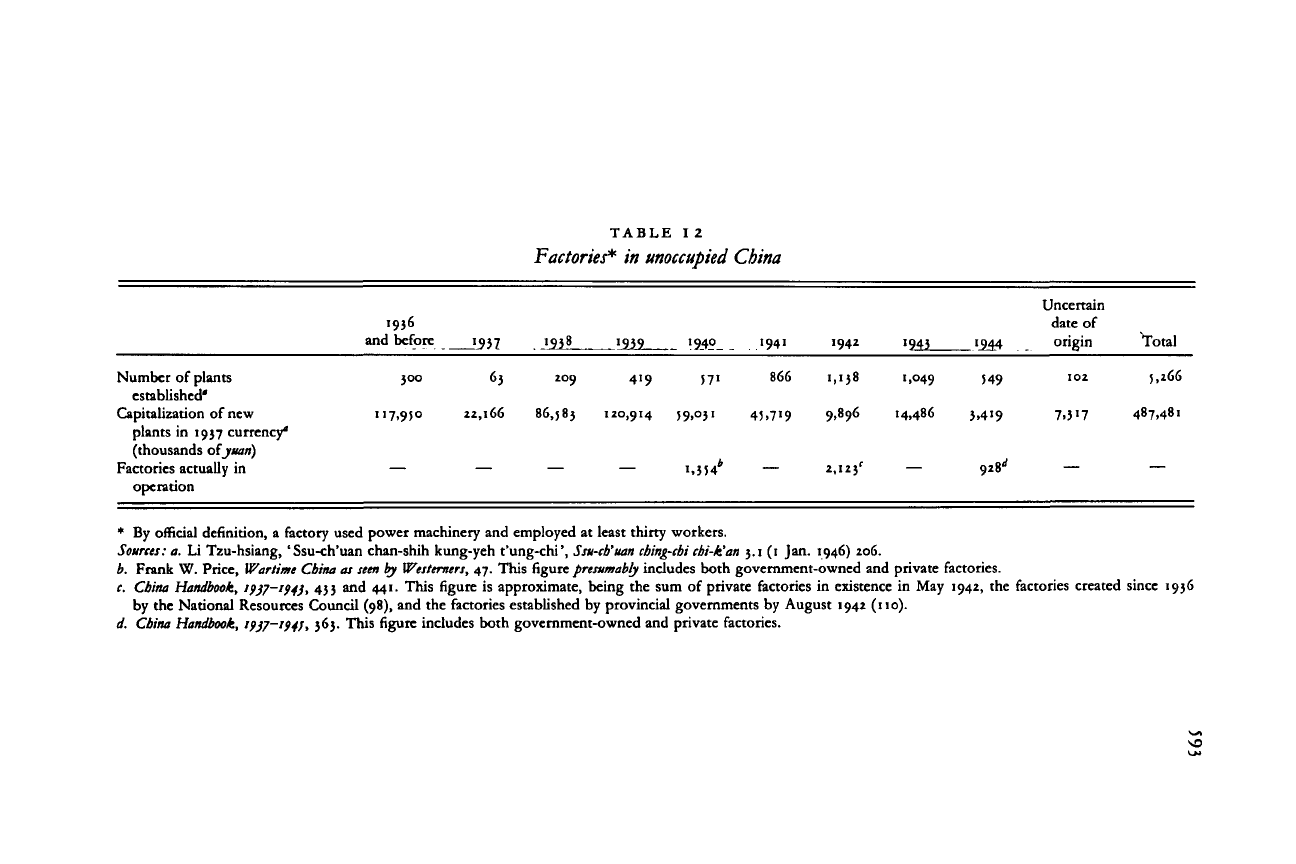
TABLE
I 2
Factories* in
unoccupied
China
1936
and before
1938 1939
1942
.•544
Uncertain
date of
origin Total
Number of plants
established'
Capitalization of new
plants in 1937 currency"
(thousands of jiian)
Factories actually in
operation
300 63 209 419 571 866 1,1)8 1,049 S49
117,950 22,166 86,583 120,914 59,031 45,719 91896 14,486 3,419
102 5,266
7.3'7 487.481
.3 54
2,123'
—
928''
* By official definition, a factory used power machinery and employed at least thirty workers.
Sources: a. Li Tzu-hsiang, 'Ssu-ch'uan chan-shih kung-yeh t'ung-chi',
Ssu-ch'uan ching-cbi
cbi-k'an 3.1 (1 Jan. 1946) 206.
b.
Frank W. Price, Wartime China as
seen
by Westerners, 47. This figure presumably includes both government-owned and private factories.
c. China Handbook, 19)7—194}, 433 and 441. This figure is approximate, being the sum of private factories in existence in May 1942, the factories created since 1936
by the National Resources Council (98), and the factories established by provincial governments by August 1942 (no).
d. China Handbook, 19)7—194;, 363. This figure includes both government-owned and private factories.
\o
Cambridge Histories Online © Cambridge University Press, 2008
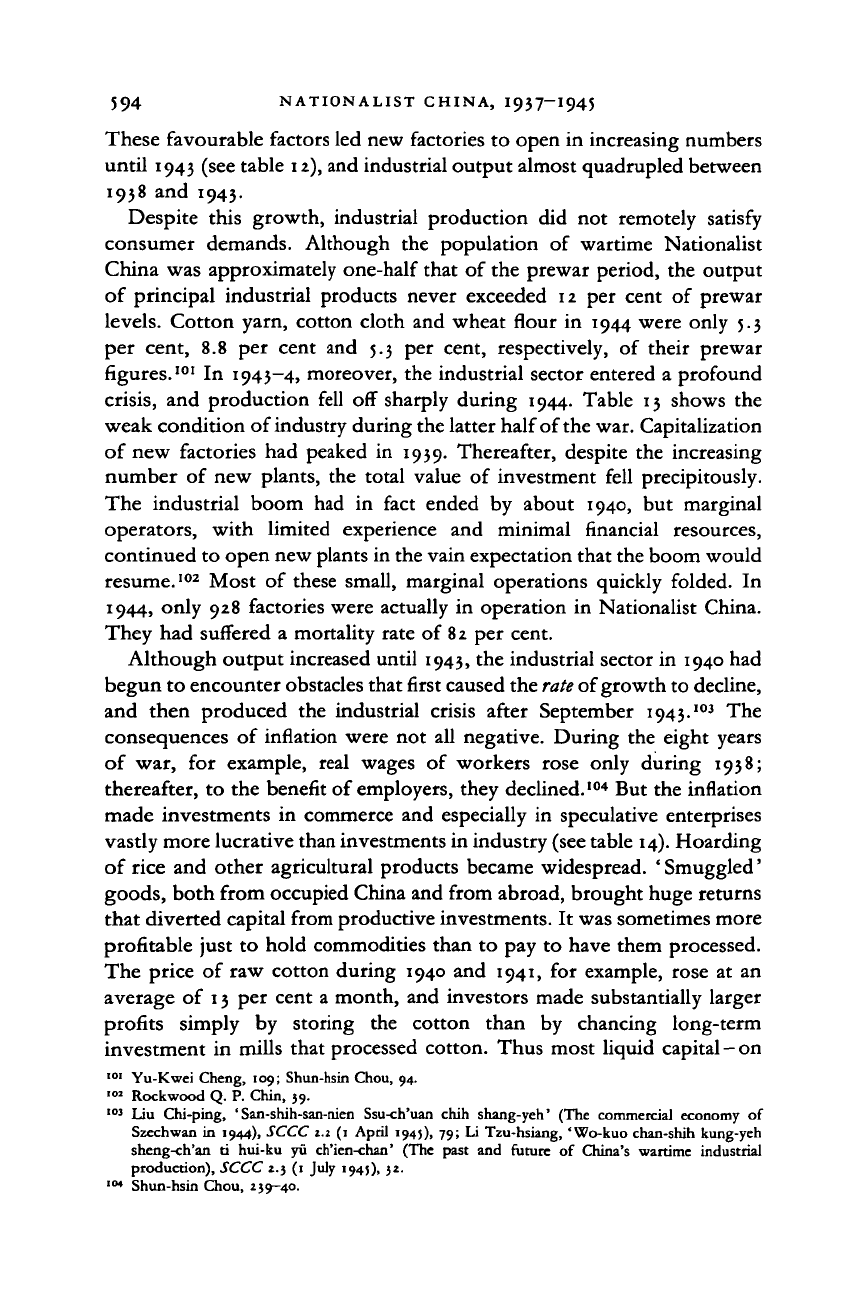
594 NATIONALIST CHINA, I937-I945
These favourable factors led new factories to open in increasing numbers
until 1943 (see table 12), and industrial output almost quadrupled between
1938 and 1943.
Despite this growth, industrial production
did not
remotely satisfy
consumer demands. Although
the
population
of
wartime Nationalist
China was approximately one-half that of the prewar period, the output
of principal industrial products never exceeded 12 per cent
of
prewar
levels.
Cotton yarn, cotton cloth and wheat flour
in
1944 were only
5.3
per cent,
8.8 per
cent and
5.3 per
cent, respectively,
of
their prewar
figures.
101
In 1943-4, moreover, the industrial sector entered
a
profound
crisis,
and production fell
off
sharply during 1944. Table 13 shows the
weak condition of industry during the latter half of the war. Capitalization
of new factories had peaked
in
1939. Thereafter, despite the increasing
number
of
new plants, the total value
of
investment fell precipitously.
The industrial boom had
in
fact ended
by
about 1940,
but
marginal
operators, with limited experience
and
minimal financial resources,
continued to open new plants in the vain expectation that the boom would
resume.
102
Most
of
these small, marginal operations quickly folded.
In
1944,
only 928 factories were actually in operation
in
Nationalist China.
They had suffered
a
mortality rate
of
82 per cent.
Although output increased until 1943, the industrial sector in 1940 had
begun to encounter obstacles that first caused the
rate
of growth to decline,
and then produced the industrial crisis after September
1943.
103
The
consequences
of
inflation were not all negative. During the eight years
of war,
for
example, real wages
of
workers rose only during 1938;
thereafter, to the benefit of employers, they declined.
104
But the inflation
made investments
in
commerce and especially
in
speculative enterprises
vastly more lucrative than investments in industry (see table 14). Hoarding
of rice and other agricultural products became widespread.
'
Smuggled'
goods, both from occupied China and from abroad, brought huge returns
that diverted capital from productive investments. It was sometimes more
profitable just to hold commodities than to pay to have them processed.
The price
of
raw cotton during 1940 and 1941,
for
example, rose
at an
average
of
13 per cent a month, and investors made substantially larger
profits simply
by
storing
the
cotton than
by
chancing long-term
investment
in
mills that processed cotton. Thus most liquid capital
-
on
101
Yu-Kwei Cheng, 109; Shun-hsin Chou, 94.
102
Rockwood
Q. P.
Chin,
39.
103
Liu
Chi-ping, ' San-shih-san-nien Ssu-ch'uan chih shang-yeh'
(The
commercial economy
of
Szechwan
in
1944), SCCC 2.2
(1
April 1945), 79;
Li
Tzu-hsiang, 'Wo-kuo chan-shih kung-yeh
sheng-ch'an
ti
hui-ku
yu
ch'ien-chan'
(The
past
and
future
of
China's wartime industrial
production), SCCC 2.3
(1
July 194;), 32.
104
Shun-hsin Chou, 239-40.
Cambridge Histories Online © Cambridge University Press, 2008
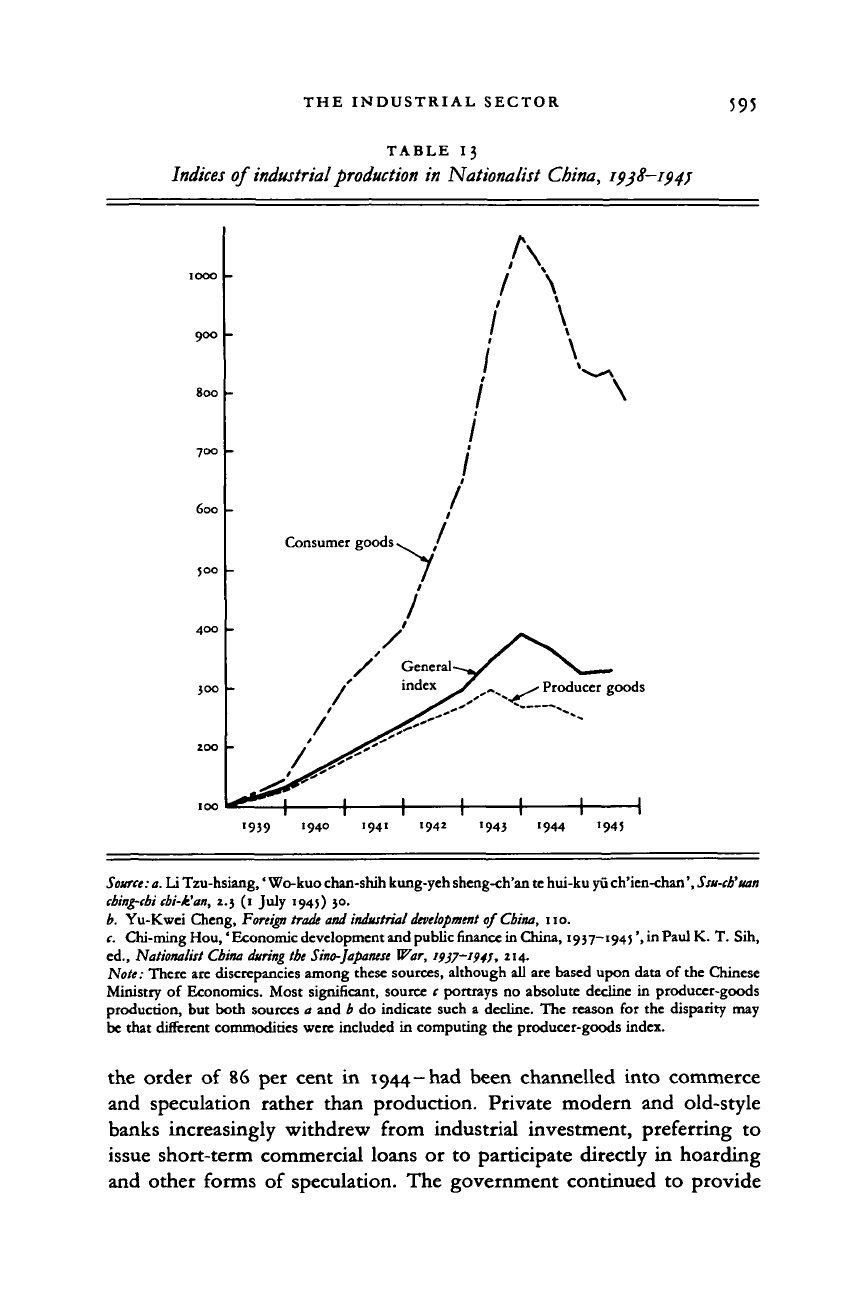
THE INDUSTRIAL SECTOR
595
TABLE 13
Indices
of industrial production in Nationalist China,
IOOO
900
800
700
600
500
400
300
200
100
-
-
_
1
1
/
1
/
Consumer goods ^^ j
!
/'
/ General—^
/ index ^/
y
/
/
i
y
A
1
\
\
N—
^^ Producer goods
_| 1 1
1939 1940 1941
1942 1943 '944 '945
Source:
a.
Li Tzu-hsiang,' Wo-kuo chan-shih kung-yeh sheng-ch'an te hui-ku yu ch'ien-chan',
Ssu-cb'uan
cbing-cbi
ebi-k'an, 2.3 (1 July 194;) 30.
b.
Yu-Kwci Cheng, Foreigi trade and industrial
development
of China, 110.
c. Chi-ming Hou,' Economic development and public finance in China, 1937—1945', in Paul K. T. Sih,
ed.,
Nationalist China during the
Sino-Japanese
War, 19J7-194J, 214.
Note: There are discrepancies among these sources, although all are based upon data of the Chinese
Ministry of Economics. Most significant, source c portrays no absolute decline in producer-goods
production, but both sources a and b do indicate such a decline. The reason for the disparity may
be that different commodities were included in computing the producer-goods index.
the order of 86 per cent in 1944 —had been channelled into commerce
and speculation rather than production. Private modern and old-style
banks increasingly withdrew from industrial investment, preferring to
issue short-term commercial loans or to participate directly in hoarding
and other forms of speculation. The government continued to provide
Cambridge Histories Online © Cambridge University Press, 2008
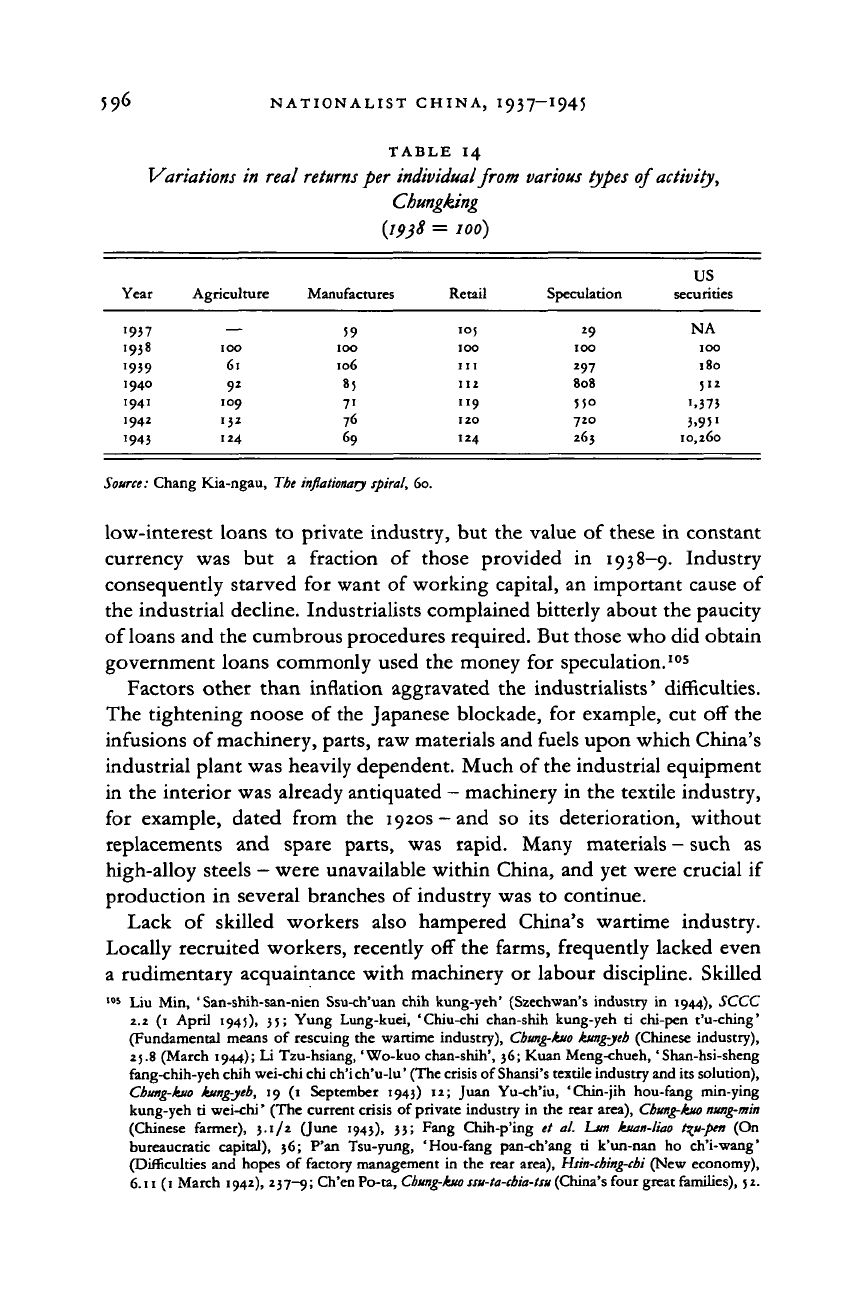
NATIONALIST CHINA, I937-I945
TABLE
14
Variations in real
returns
per individual from
various
types of activity,
Chungking
= 100)
Year
1937
1938
"939
1940
1941
1942
1943
Agriculture
—
100
61
9*
109
'3*
124
Manufactures
59
100
106
85
71
76
69
Retail
105
100
in
112
119
120
124
Speculation
*9
ICO
2
97
808
55°
720
265
US
securities
NA
100
180
5"
i,373
3.95
>
10,260
Source:
Chang Kia-ngau, Tie
inflationary
spiral,
60.
low-interest loans to private industry, but the value of these in constant
currency was but a fraction of those provided in 1938—9. Industry
consequently starved for want of working capital, an important cause of
the industrial decline. Industrialists complained bitterly about the paucity
of loans and the cumbrous procedures required. But those who did obtain
government loans commonly used the money for speculation.
105
Factors other than inflation aggravated the industrialists' difficulties.
The tightening noose of the Japanese blockade, for example, cut off the
infusions of machinery, parts, raw materials and fuels upon which China's
industrial plant was heavily dependent. Much of the industrial equipment
in the interior was already antiquated - machinery in the textile industry,
for example, dated from the 1920s-and so its deterioration, without
replacements and spare parts, was rapid. Many materials - such as
high-alloy steels - were unavailable within China, and yet were crucial if
production in several branches of industry was to continue.
Lack of skilled workers also hampered China's wartime industry.
Locally recruited workers, recently off the farms, frequently lacked even
a rudimentary acquaintance with machinery or labour discipline. Skilled
IOS
Liu Min, ' San-shih-san-nien Ssu-ch'uan chih kung-yeh' (Szechwan's industry in 1944), SCCC
2.2 (1 April 1945), 35; Yung Lung-kuei, 'Chiu-chi chan-shih kung-yeh ti chi-pen t'u-ching'
(Fundamental means of rescuing the wartime industry),
Cbung-hio kung-jcb
(Chinese industry),
25.8 (March 1944); Li Tzu-hsiang, 'Wo-kuo chan-shih', 36; Kuan Meng-chueh,'Shan-hsi-sheng
fang-chih-yeh chih wei-chi chi ch'i ch*u-lu' (The crisis of Shansi's textile industry and its solution),
Cbung-ha hmg-jeb, 19 (1 September 1943) 12; Juan Yu-ch'iu, 'Chin-jih hou-fang min-ying
kung-yeh ti wei-chi' (The current crisis of private industry in the rear area),
Cbung-kuo nung-min
(Chinese farmer), 3.1/2 (June 1943), 33; Fang Chih-p'ing et al.
LJOI
kuan-liao
t^u-pen
(On
bureaucratic capital), 36; P'an Tsu-yung, 'Hou-fang pan-ch'ang ti k'un-nan ho ch'i-wang'
(Difficulties and hopes of factory management in the rear area),
Hsin-cbing-cbi
(New economy),
6.11 (1 March 1942), 237-9; Ch'enPo-ta,
Cbung-kuo ssu-ta-cbia-tsu
(China's four great families), 52.
Cambridge Histories Online © Cambridge University Press, 2008

THE INDUSTRIAL SECTOR 597
industrial labourers, therefore, had to be recruited from cities on the coast.
By 1940, however, only some 42,000 of these had followed the Nationalist
government into the interior. Factory managers began poaching upon
other factories in their quest for skilled employees. This competition drove
up wages. It also contributed to a destructively high rate of labour
turnover —in 1940, about 10 per cent a month for skilled workers and 18
per cent for unskilled. In May 1943, the monthly turnover for all workers
was 23 per cent. This prodigious instability, together with the general
shortage of
skills
and the deterioration of equipment, led to a rapid decline
in worker efficiency. In textile mills, for example, it was judged to be about
60-8
5
per cent of prewar levels. An electrical worker estimated that the
efficiency of his factory was only one-third what it had been in
Shanghai.
106
Paradoxically, some industries ran into a lack of consumer demand. The
steady impoverishment of people limited their spending to only the most
critical necessities. The market for textile goods became sluggish, despite
the people's desperate need for new clothing, because their purchasing
power had collapsed. Weakened demand also struck the manufacturers
of producer goods. The iron industry, for example, had flourished prior
to 1942 due to the construction of railways and air-raid shelters. When
the government gave up such projects, the iron industry lapsed into the
doldrums, injuring related sectors such as coal and coke. Demand for
industrial machinery and military equipment remained high. But China's
iron-and-steel manufacturers usually could not satisfy it, because they
lacked the equipment, raw materials, and skilled labour required.
107
To combat the inflation, the government had first tried as early as
December 1938 to fix the prices of daily necessities. This quickly proved
ineffective. Subsequently the government promulgated a rash of new
regulations to eliminate speculation in commodities and to hold down
the prices of food, industrial materials and rents. By October 1941,
however, the Bank of China pronounced all these measures a ' complete
failure'.
108
The Nationalists' interest in price controls revived after the United
106 Freyn, Free China's
New
Deal,
41; Kuo-heng Shih, 60-1, 134;
CHB,
1937-194!, 385;
Ta
Chen,
55-6 and 122, table
58;
Ch'en
Ta,
'Chung-Kuo lao-kung chieh-chi
yii
tang-ch'ien ching-chi
wei-chi' (China's working class
and the
current economic crisis), Sbe-bui cbien-sbe (Social
reconstruction), 1.4 (1 Aug. 1948), 17; Li Tzu-hsiang,' K'ang-chan i-lai', 43; Israel Epstein, Notes
on labor problems in Nationalist Cbina, 20-8.
107
Liu Chi-ping, 79; Yung Lung-kuei,
8;
T'ao Ta-yung, 'Lun tang-ch'ien
ti
kung-yeh chiu-chi'
(Current means
of
rescuing industry), Cbung-kuo hmg-yeh (Chinese industry), 25.11 (Mar. 1944);
Liu Min, 36-7.
108
Chang Kia-ngau, Inflationary spiral, 344; Young, China's wartime finance, 144;
T/ai-cbeng
p'ing-lun
(Financial review), 5.1 (Jan. 1941), 25-37.
Cambridge Histories Online © Cambridge University Press, 2008
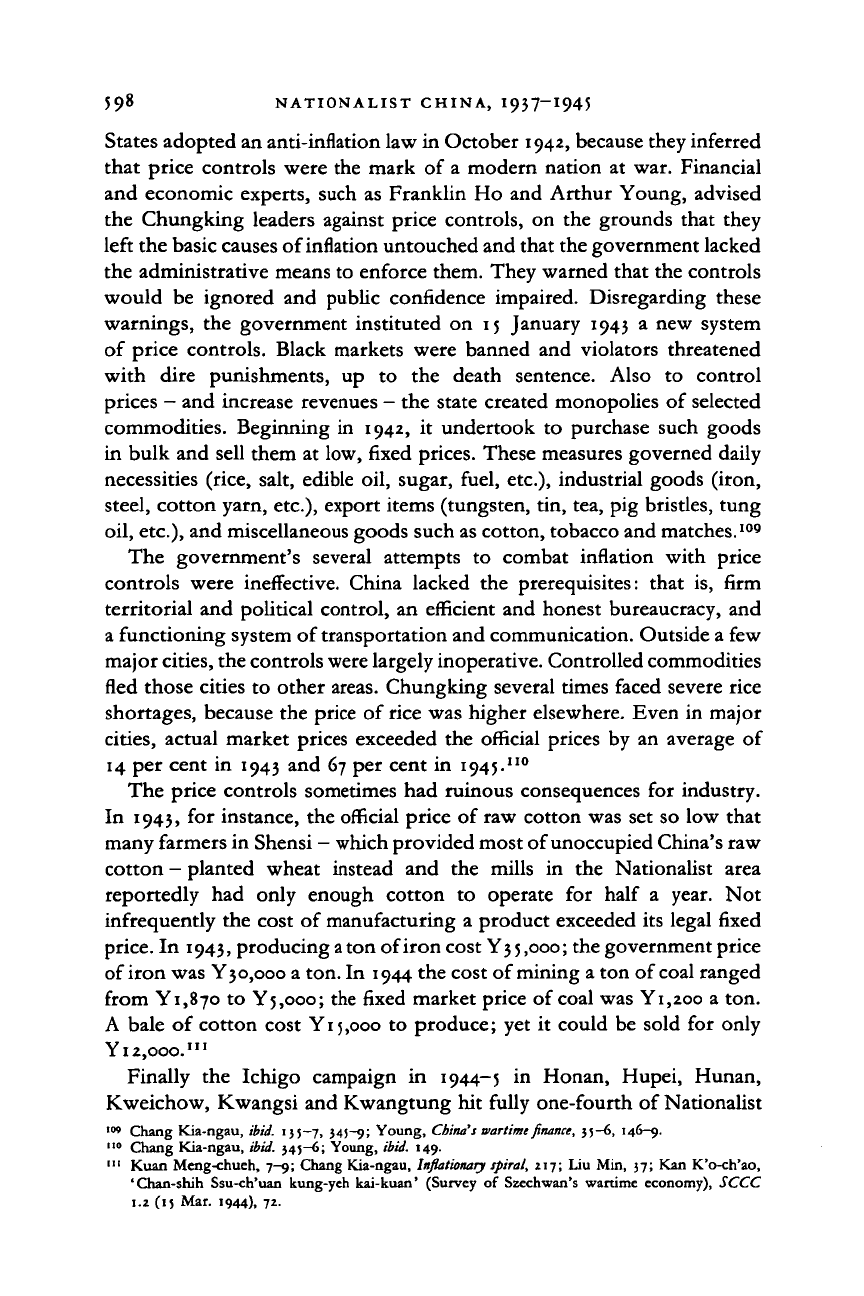
59
8
NATIONALIST CHINA, I937-I945
States adopted an anti-inflation law in October 1942, because they inferred
that price controls were the mark of a modern nation
at
war. Financial
and economic experts, such as Franklin Ho and Arthur Young, advised
the Chungking leaders against price controls,
on
the grounds that they
left the basic causes of inflation untouched and that the government lacked
the administrative means to enforce them. They warned that the controls
would
be
ignored and public confidence impaired. Disregarding these
warnings, the government instituted on 15 January 1943
a
new system
of price controls. Black markets were banned and violators threatened
with dire punishments,
up to the
death sentence. Also
to
control
prices
-
and increase revenues
-
the state created monopolies of selected
commodities. Beginning in 1942,
it
undertook
to
purchase such goods
in bulk and sell them at low, fixed prices. These measures governed daily
necessities (rice, salt, edible oil, sugar, fuel, etc.), industrial goods (iron,
steel, cotton yarn, etc.), export items (tungsten, tin, tea, pig bristles, tung
oil,
etc.), and miscellaneous goods such as cotton, tobacco and matches.
100
The government's several attempts
to
combat inflation with price
controls were ineffective. China lacked the prerequisites: that is, firm
territorial and political control, an efficient and honest bureaucracy, and
a functioning system of transportation and communication. Outside a few
major
cities,
the controls were largely inoperative. Controlled commodities
fled those cities to other areas. Chungking several times faced severe rice
shortages, because the price of rice was higher elsewhere. Even in major
cities,
actual market prices exceeded the official prices by an average
of
14 per cent in 1943 and 67 per cent in 1945.
no
The price controls sometimes had ruinous consequences for industry.
In 1943, for instance, the official price of raw cotton was set so low that
many farmers in Shensi
-
which provided most of unoccupied China's raw
cotton
-
planted wheat instead
and the
mills
in the
Nationalist area
reportedly
had
only enough cotton
to
operate
for
half
a
year.
Not
infrequently the cost of manufacturing a product exceeded its legal fixed
price. In
1943,
producing
a
ton of iron cost Y35,ooo; the government price
of iron was Y3o,ooo a ton. In 1944 the cost of mining a ton of
coal
ranged
from Yi,87o to Y5,ooo; the fixed market price of coal was Yi,2oo a ton.
A bale
of
cotton cost Yi
5,000
to produce; yet
it
could be sold for only
Y 12,00c.
111
Finally
the
Ichigo campaign
in
1944-5
in
Honan, Hupei, Hunan,
Kweichow, Kwangsi and Kwangtung hit fully one-fourth of Nationalist
"*>
Chang Kia-ngau,
ibid.
155—7, 34S~9; Young, China's wartime finance, 35-6, 146-9.
110
Chang Kia-ngau,
ibid.
545—6; Young,
ibid.
149.
"' Kuan Meng-chueh, 7-9; Chang Kia-ngau, Inflationary spiral, 217; Liu Min, 37; Kan K'o-ch'ao,
'Chan-shih Ssu-ch'uan kung-yeh kai-kuan' (Survey
of
Szechwan's wartime economy), SCCC
1.2 (15 Mar. 1944), 72.
Cambridge Histories Online © Cambridge University Press, 2008
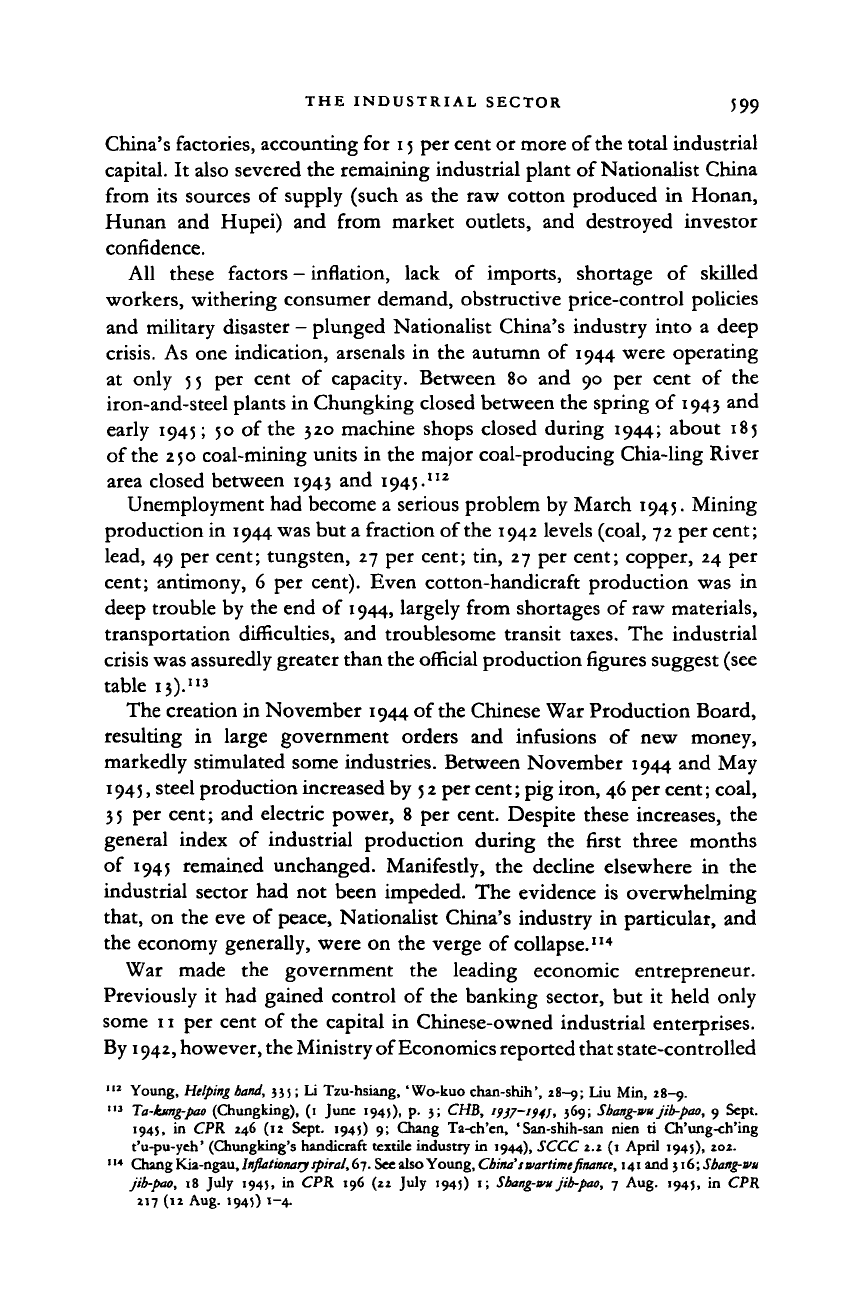
THE INDUSTRIAL SECTOR 599
China's factories, accounting for 15 per cent or more of the total industrial
capital. It also severed the remaining industrial plant of Nationalist China
from its sources of supply (such as the raw cotton produced in Honan,
Hunan and Hupei) and from market outlets, and destroyed investor
confidence.
All these factors
—
inflation, lack of imports, shortage of skilled
workers, withering consumer demand, obstructive price-control policies
and military disaster - plunged Nationalist China's industry into a deep
crisis.
As one indication, arsenals in the autumn of 1944 were operating
at only
5 5
per cent of capacity. Between 80 and 90 per cent of the
iron-and-steel plants in Chungking closed between the spring of 1943 and
early 1945; 50 of the 320 machine shops closed during 1944; about 185
of the 250 coal-mining units in the major coal-producing Chia-ling River
area closed between 1943 and 1945.
nz
Unemployment had become a serious problem by March 1945. Mining
production in 1944 was but a fraction of the 1942 levels (coal, 72 per cent;
lead, 49 per cent; tungsten, 27 per cent; tin, 27 per cent; copper, 24 per
cent; antimony, 6 per cent). Even cotton-handicraft production was in
deep trouble by the end of 1944, largely from shortages of raw materials,
transportation difficulties, and troublesome transit taxes. The industrial
crisis was assuredly greater than the official production figures suggest (see
table 13).»"
The creation in November 1944 of the Chinese War Production Board,
resulting in large government orders and infusions of new money,
markedly stimulated some industries. Between November 1944 and May
1945,
steel production increased by
5 2
per cent; pig iron, 46 per cent; coal,
35 per cent; and electric power, 8 per cent. Despite these increases, the
general index of industrial production during the first three months
of 1945 remained unchanged. Manifestly, the decline elsewhere in the
industrial sector had not been impeded. The evidence is overwhelming
that, on the eve of peace, Nationalist China's industry in particular, and
the economy generally, were on the verge of collapse.
114
War made the government the leading economic entrepreneur.
Previously it had gained control of the banking sector, but it held only
some 11 per cent of the capital in Chinese-owned industrial enterprises.
By
1942,
however, the Ministry of Economics reported that state-controlled
112
Young, Helping
band,
335;
Li
Tzu-hsiang, 'Wo-kuo chan-shih',
28-9; Liu Min, 28-9.
113
Ta-kung-pao
(Chungking),
(1
June 194;),
p. 3; CHB,
'9}7—i94J,
369;
Sbang-wu jib-pao,
9
Sept.
1945,
in CPR 246 (12
Sept.
1945) 9;
Chang
Ta-ch'en,
'San-shih-san nien
ti
Ch'ung-ch'ing
t'u-pu-yeh'
(Chungking's handicraft textile industry
in
1944),
SCCC
2.2 (1
April
1945),
202.
114
Chang Kia-ngau, Inflationary
spiral,
67. See also Young, China's wartime
finance,
141 and
316;
Sbang-wu
jib-poo,
18
July
1945, in CPR 196 (22
July
1945) 1;
Sbang-mi
jib-pao,
7 Aug. 1945, in CPR
217 (12 Aug.
1945) 1-4.
Cambridge Histories Online © Cambridge University Press, 2008
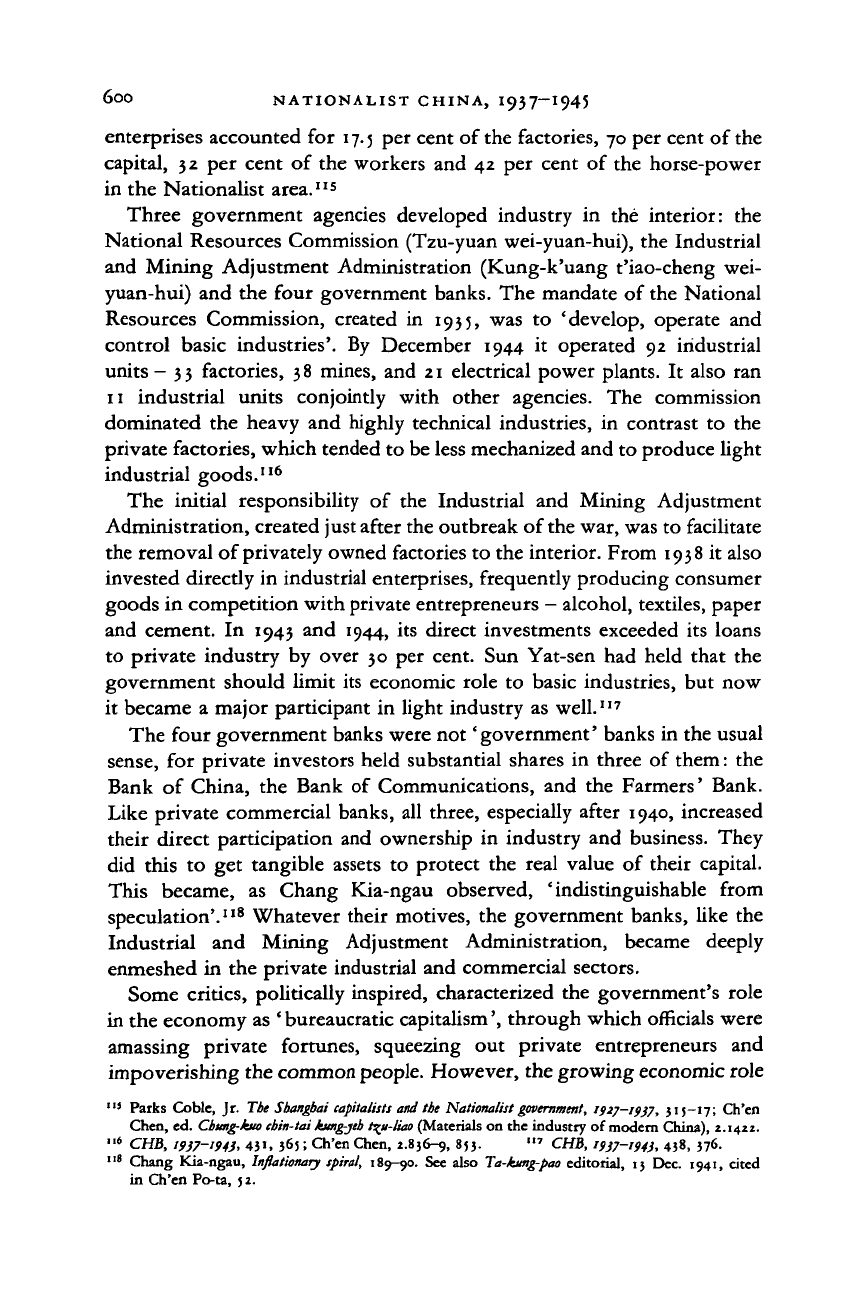
6O0 NATIONALIST CHINA, I937-I945
enterprises accounted for 17.5 per cent of the factories, 70 per cent of the
capital,
3 2
per cent of the workers and 42 per cent of the horse-power
in the Nationalist area.
IIS
Three government agencies developed industry in the interior: the
National Resources Commission (Tzu-yuan wei-yuan-hui), the Industrial
and Mining Adjustment Administration (Kung-k'uang t'iao-cheng wei-
yuan-hui) and the four government banks. The mandate of the National
Resources Commission, created in 1935, was to 'develop, operate and
control basic industries'. By December 1944 it operated 92 industrial
units -
3 3
factories,
3 8
mines, and 21 electrical power plants. It also ran
11 industrial units conjointly with other agencies. The commission
dominated the heavy and highly technical industries, in contrast to the
private factories, which tended to be less mechanized and to produce light
industrial goods.
116
The initial responsibility of the Industrial and Mining Adjustment
Administration, created just after the outbreak of
the
war, was to facilitate
the removal of privately owned factories to the interior. From 1938 it also
invested directly in industrial enterprises, frequently producing consumer
goods in competition with private entrepreneurs
—
alcohol, textiles, paper
and cement. In 1943 and 1944, its direct investments exceeded its loans
to private industry by over 30 per cent. Sun Yat-sen had held that the
government should limit its economic role to basic industries, but now
it became a major participant in light industry as well.
117
The four government banks were not 'government' banks in the usual
sense, for private investors held substantial shares in three of them: the
Bank of China, the Bank of Communications, and the Farmers' Bank.
Like private commercial banks, all three, especially after 1940, increased
their direct participation and ownership in industry and business. They
did this to get tangible assets to protect the real value of their capital.
This became, as Chang Kia-ngau observed, 'indistinguishable from
speculation'.
118
Whatever their motives, the government banks, like the
Industrial and Mining Adjustment Administration, became deeply
enmeshed in the private industrial and commercial sectors.
Some critics, politically inspired, characterized the government's role
in the economy as ' bureaucratic capitalism', through which officials were
amassing private fortunes, squeezing out private entrepreneurs and
impoverishing the common
people.
However, the growing economic role
115
Parks Coble, Jr. The Shanghai capitalists and the Nationalist
government,
1927-1937, 515—17; Ch'en
Chen,
ed.
Cbimg-kuo cbin-tai kung-jeb
t^u-liao
(Materials
on the
industry
of
modern China), 2.1422.
116
CHB,
19)7-194),
431,
365; Ch'en Chen, 2.856-9,
853. '" CHB, 19)7-194), 438, 376.
118
Chang Kia-ngau,
Inflationary
spiral,
189-90.
See
also Ta-kung-pao editorial,
15 Dec. 1941,
cited
in Ch'en Po-ta,
5
2.
Cambridge Histories Online © Cambridge University Press, 2008
